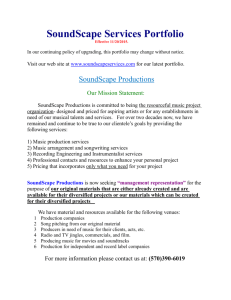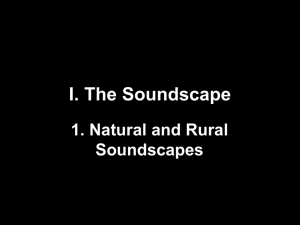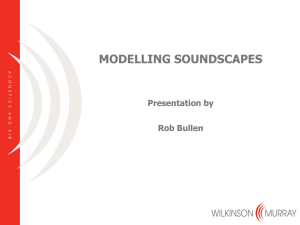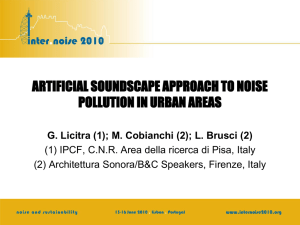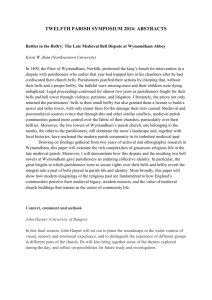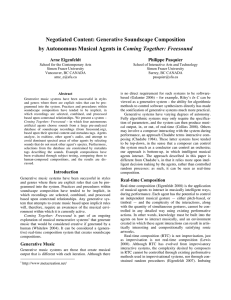ÇANKAYA UNIVERSITY - FACULTY OF ARCHITECTURE
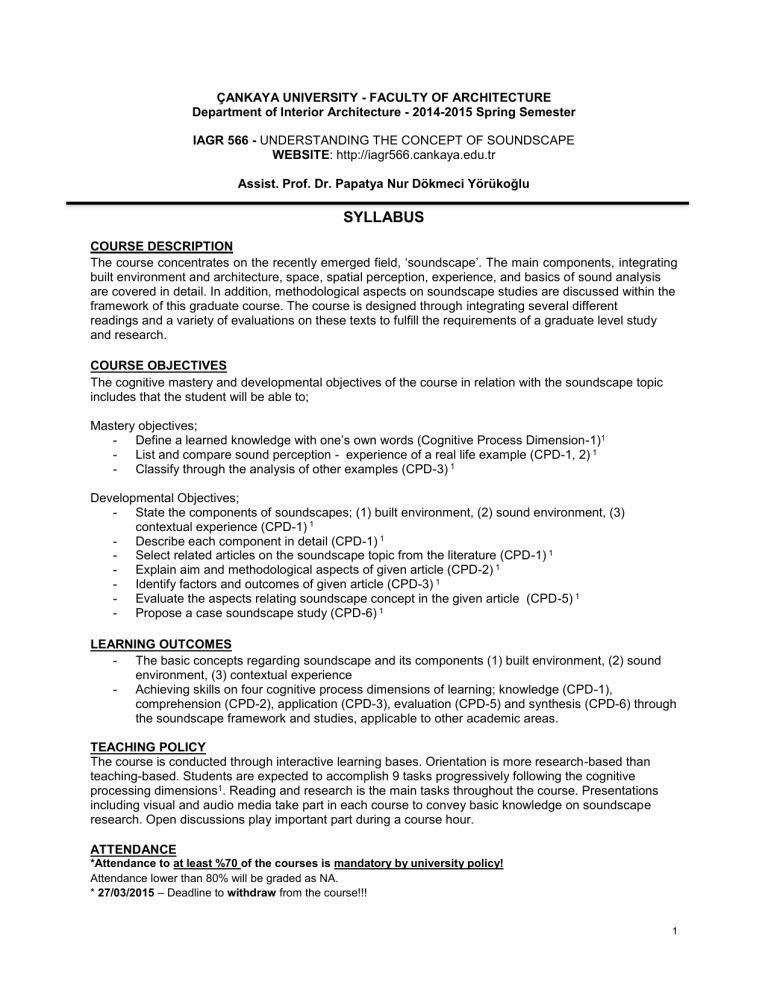
ÇANKAYA UNIVERSITY - FACULTY OF ARCHITECTURE
Department of Interior Architecture - 2014-2015 Spring Semester
IAGR 566 - UNDERSTANDING THE CONCEPT OF SOUNDSCAPE
WEBSITE : http://iagr566.cankaya.edu.tr
Assist. Prof. Dr. Papatya Nur Dökmeci Yörükoğlu
SYLLABUS
COURSE DESCRIPTION
The course concentrates on the recently emerged field, ‘soundscape’. The main components, integrating built environment and architecture, space, spatial perception, experience, and basics of sound analysis are covered in detail. In addition, methodological aspects on soundscape studies are discussed within the framework of this graduate course. The course is designed through integrating several different readings and a variety of evaluations on these texts to fulfill the requirements of a graduate level study and research.
COURSE OBJECTIVES
The cognitive mastery and developmental objectives of the course in relation with the soundscape topic includes that the student will be able to;
Mastery objectives;
- Define a learned knowledge with one’s own words (Cognitive Process Dimension-1) 1
- List and compare sound perception - experience of a real life example (CPD-1, 2) 1
- Classify through the analysis of other examples (CPD-3) 1
Developmental Objectives;
- State the components of soundscapes; (1) built environment, (2) sound environment, (3) contextual experience (CPD-1) 1
- Describe each component in detail (CPD-1) 1
- Select related articles on the soundscape topic from the literature (CPD-1) 1
- Explain aim and methodological aspects of given article (CPD-2) 1
- Identify factors and outcomes of given article (CPD-3) 1
- Evaluate the aspects relating soundscape concept in the given article (CPD-5) 1
- Propose a case soundscape study (CPD-6) 1
LEARNING OUTCOMES
- The basic concepts regarding soundscape and its components (1) built environment, (2) sound environment, (3) contextual experience
- Achieving skills on four cognitive process dimensions of learning; knowledge (CPD-1), comprehension (CPD-2), application (CPD-3), evaluation (CPD-5) and synthesis (CPD-6) through the soundscape framework and studies, applicable to other academic areas.
TEACHING POLICY
The course is conducted through interactive learning bases. Orientation is more research-based than teaching-based. Students are expected to accomplish 9 tasks progressively following the cognitive processing dimensions 1 . Reading and research is the main tasks throughout the course. Presentations including visual and audio media take part in each course to convey basic knowledge on soundscape research. Open discussions play important part during a course hour.
ATTENDANCE
*Attendance to at least %70 of the courses is mandatory by university policy!
Attendance lower than 80% will be graded as NA.
* 27/03/2015 – Deadline to withdraw from the course!!!
1
ASSESSMENT
Homeworks (9)
Midterm Evaluation
Final Assignment
Interest/Participation
REFERENCE BOOKS
45%
15%
30%
10%
Author(s)
MURRAYR. SCHAFER
BARRY BLESSER, LINDA-
RUTH SALTER
Ed. COLIN RIPLEY, MARCO
POLO, ARTHUR
WRIGGLESWORTH
YI-FU TUAN
E RELPH
Title
OUR SONIC ENVIRONMENT AND THE
SOUNDSCAPE, THE TUNING OF THE WORLD
SPACES SPEAK, ARE YOU LISTENING?
IN THE PLACE OF SOUND
– ARCHITECTURE,
MUSIC, ACOUSTICS
SPACE AND PLACE
PLACE AND PLACELESSNESS
Publisher
Publication
Year
DESTINY
BOOKS
THE MIT
PRESS
CAMBRIDGE
SCHOLARS
PUBLISHING
UNIVERSITY
OF
MINNESOTA
PRESS
1994
2007
2007
2011
PION LIMITED 1976
BILL HILLIER, JULIENNE
HANSON
THE SOCIAL LOGIC OF SPACE
CAMBRIDGE
UNIVERSITY
PRESS
1997
1 LORIN W. ANDERSON,
DAVID R. KRATHWOHL,
PETER W. AIRASIAN,
KATHLEEN A. CRUIKSHANK,
RICHARD E. MAYER, PAUL
R. PINTRICH, JAMES
RATHS, MERLIN C.
WITTROCK
A Taxonomy for Learning, Teaching, and Assessing: A
Revision of Bloom's Taxonomy of Educational
Objectives
Abridged
Edition 2000
Krathwohl, David R. (2002). "A revision of Bloom's taxonomy: An overview". Theory Into Practice (Routledge) 41 (4): 212 –
218.
COURSE OUTLINE
WEEK DATE TOPIC(S)
1
2
February, 2015
Introduction: Soundscape and its components
PRE-TEST FOR THE GENERAL KNOWLEDGE ON THE TOPIC
Sound and Soundscape - Definitions and Terms
ASSIGNMENT 1: DEFINING IN YOUR OWN WORDS
(COGNITIVE PROCESS DIMENSION-1)
February, 2015
READING 1A : Introduction (Schaffer, 1994, Our Sonic Environment and the
Soundscape, pg. 3-12)
READING 1B: Introduction to Aural Architecture (Blesser, Salter, 2007, Spaces
Speak, Are You Listening?, pg. 1-9)
3
The Psychological State: Expectation, Perception, Reaction
February, 2015
ASSIGNMENT 2: LISTING & EXPERIENTIAL COMPARISON (MIND TO PAPER)
(COGNITIVE PROCESS DIMENSION-1 and 2)
READING 2: Media Acoustics: Sounds of the American Public Library (Shannon
Mattern, ed. Ripley, 2007, In the Place of Sound, pg. 135-144)
2
6
7
4
5
8
9
10
Contextual Experience
ASSIGNMENT 3: COMPARATIVE DISCUSSION REPORT
(COGNITIVE PROCESS DIMENSION-2)
March, 2015
READING 3A: Ch2: Experiential perspective (Tuan, 2011, Space and Place, pg. 8-18)
READING 3B: Ch1: Place and the phenomenological basis of geography, Ch2: Space and Place (Relph, 1976, Place and Placelessness, pg. 1-29)
READING 3C: Ch1: The problem of space (Hillier, Hanson, 1997, The Social Logic of
Space, pg. 26-33)
Architectonic Soundscapes: Analysis on Architecture and Space
ASSIGNMENT 4: SUMMARY
March, 2015
(COGNITIVE PROCESS DIMENSION-2)
READING 4: Inhabiting Soundscapes: Architecture of the Unseen World (Matteo
Melioli, ed. Ripley, 2007, In the Place of Sound, pg. 135-144)
The Functions within Built Environment
March, 2015
REVIEW AND GETTING READY FOR MIDTERM
March, 2015 MIDTERM EVALUATION on Covered Topics and Readings
Sounds of Daily Life and Soundscape Classifications
ASSIGNMENT 5: CLASSIFICATION PROPOSAL
(COGNITIVE PROCESS DIMENSION-3)
April, 2015
READING 5A: Ch9: Classification (Schaffer, 1994, Our Sonic Environment and the
Soundscape, pg. 133-150)
READING 5B: Towards standardization in soundscape preference assessment
(Brown, Kang, Gjestland, 2011, Applied Acoustics 72, pg. 387
–392)
April, 2015
Understanding Soundscape Research in the Literature and Its Methodology
ASSIGNMENT 6: SELECT MIN. 3 ARTICLES
(COGNITIVE PROCESS DIMENSION-1)
The Objective Matters on Sound and Soundscapes
ASSIGNMENT 7: EXPLAIN AIM & METHODOLOGY
(COGNITIVE PROCESS DIMENSION-2)
April, 2015
READING 7: Indoor soundscaping of different public spaces: analysis on sound environment, architecture and function (Dokmeci, Kang, Johnson, 2011, Forum
Acusticum Conf. Proc.)
3
13
14
11
12
The Subjective Matters on Sound and Soundscapes
ASSIGNMENT 8: IDENTIFY FACTORS & OUTCOMES
April, 2015
(COGNITIVE PROCESS DIMENSION-3)
READING 8: A comparative case study of indoor soundscape approach on objective analyses and subjective evaluations of libraries (Dokmeci, Kang, 2012, Acoustics
Conf. Proc.)
Evaluation of Sound as Resource not Noise and Its Impacts on Community
ASSIGNMENT 9: EVALUATE (APPRAISE)
April, 2015
(COGNITIVE PROCESS DIMENSION-5)
READING 5: Soundscape: An approach to rely on human perception and expertise in the post-modern community noise era (Schulte-Fortkamp, Brooks, Bray, 2007,
Acoustics Today, 3,1, pg. 7-14)
How to Design a Soundscape Study
May, 2015
FINAL ASSIGNMENT
– PLAN/PROPOSE YOUR SOUNDSCAPE STUDY
(COGNITIVE PROCESS DIMENSION-6)
FINAL PRESENTATIONS by the students
May, 2015
POST-TEST FOR THE AFTER COURSE LEARNED KNOWLEDGE/AWARENESS
4
